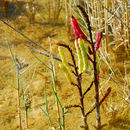en
names in breadcrumbs


Salicornia rubra is very similar to the Eurasian species S. prostrata Pallas, which occurs in very similar inland habitats. No direct comparison of these two species has been possible and it is not at all clear how they differ from each other.
Salicornia rubra, the Rocky Mountain glasswort, is a species of flowering plant in the family Amaranthaceae.[2] It is native to colder or higher areas of North America; the Yukon, Nunavut, British Columbia, Alberta, Saskatchewan, Manitoba, and Ontario in Canada, and the western and north-central US. It has been introduced to Quebec and Michigan, and has gone extinct in Illinois.[1] A halophyte, it is one of the most salt-tolerant plants of North America.[3]
Salicornia rubra, the Rocky Mountain glasswort, is a species of flowering plant in the family Amaranthaceae. It is native to colder or higher areas of North America; the Yukon, Nunavut, British Columbia, Alberta, Saskatchewan, Manitoba, and Ontario in Canada, and the western and north-central US. It has been introduced to Quebec and Michigan, and has gone extinct in Illinois. A halophyte, it is one of the most salt-tolerant plants of North America.